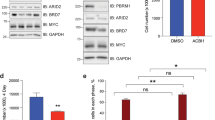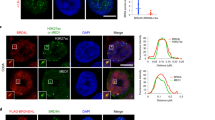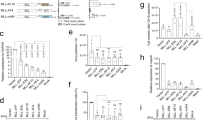Abstract
The mammalian SWI/SNF chromatin remodeling complex is composed of more than 10 protein subunits, and plays important roles in epigenetic regulation. Each complex includes a single BRG1 or Brm molecule as the catalytic subunit. We previously reported that loss of Brm, but not BRG1, causes transcriptional gene silencing of murine leukemia virus-based retrovirus vectors. To understand the biological function and biogenesis of Brm protein, we examined seven cell lines derived from various human tumors that do not produce Brm protein. We show here that these Brm-deficient cell lines transcribe the Brm genes efficiently as detected by nuclear run-on transcription assay, whereas Brm mRNA and Brm hnRNA were undetectable by reverse transcription–polymerase chain reaction analysis. These results indicate that expression of Brm is strongly and promptly suppressed at the post-transcriptional level, through processing and transport of the primary transcript or through stability of mature Brm mRNA. This suppression was attenuated by transient treatment of these cell lines with HDAC inhibitors probably through indirect mechanism. Importantly, all of the treated cells showed prolonged induction of Brm expression after the removal of HDAC inhibitors, and acquired the ability to maintain retroviral gene expression. These results indicate that these Brm-deficient human tumor cell lines carry a functional Brm gene. Treatment with HDAC inhibitors or introduction of exogenous Brm into Brm-deficient cell lines significantly reduced the oncogenic potential as assessed by colony-forming activity in soft agar or invasion into collagen gel, indicating that, like BRG1, Brm is involved in tumor suppression.
This is a preview of subscription content, access via your institution
Access options
Subscribe to this journal
Receive 50 print issues and online access
$259.00 per year
only $5.18 per issue
Buy this article
- Purchase on Springer Link
- Instant access to full article PDF
Prices may be subject to local taxes which are calculated during checkout





Similar content being viewed by others
References
Arai T, Matsumoto K, Saitoh K, Ui M, Ito T, Murakami M, Kanegae Y, Saito I, Cosset FL, Takeuchi Y and Iba H . (1998). J. Virol., 72, 1115–1121.
Barker N, Hurlstone A, Musisi H, Miles A, Bienz M and Clevers H . (2001). EMBO J., 20, 4935–4943.
Betz BL, Strobeck MW, Reisman DN, Knudsen ES and Weissman BE . (2002). Oncogene, 21, 5193–5203.
Biegel JA, Zhou JY, Rorke LB, Stenstrom C, Wainwright LM and Fogelgren B . (1999). Cancer Res., 59, 74–79.
Bourachot B, Yaniv M and Muchardt C . (2003). EMBO J., 22, 6505–6515.
Bultman S, Gebuhr T, Yee D, La Mantia C, Nicholson J, Gilliam A, Randazzo F, Metzger D, Chambon P, Crabtree G and Magnuson T . (2000). Mol. Cell., 6, 1287–1295.
Cheng SW, Davies KP, Yung E, Beltran RJ, Yu J and Kalpana GV . (1999). Nat. Genet., 22, 102–105.
DeCristofaro MF, Betz BL, Rorie CJ, Reisman DN, Wang W and Weissman BE . (2001). J. Cell. Physiol., 186, 136–145.
DeCristofaro MF, Betz BL, Wang W and Weissman BE . (1999). Oncogene, 18, 7559–7565.
Doan DN, Veal TM, Yan Z, Wang W, Jones SN and Imbalzano AN . (2004). Oncogene, 23, 3462–3473.
Dunaief JL, Strober BE, Guha S, Khavari PA, Alin K, Luban J, Begemann M, Crabtree GR and Goff SP . (1994). Cell, 79, 119–130.
Esteller M . (2002). Oncogene, 21, 5427–5440.
Furumai R, Matsuyama A, Kobashi N, Lee KH, Nishiyama M, Nakajima H, Tanaka A, Komatsu Y, Nishino N, Yoshida M and Horinouchi S . (2002). Cancer Res., 62, 4916–4921.
Geng F, Cao Y and Laurent BC . (2001). Mol. Cell. Biol., 21, 4311–4320.
Guidi CJ, Sands AT, Zambrowicz BP, Turner TK, Demers DA, Webster W, Smith TW, Imbalzano AN and Jones SN . (2001). Mol. Cell. Biol., 21, 3598–3603.
Iba H, Mizutani T and Ito T . (2003). Rev. Med. Virol., 13, 99–110.
Ito T, Yamauchi M, Nishina M, Yamamichi N, Mizutani T, Ui M, Murakami M and Iba H . (2001). J. Biol. Chem., 276, 2852–2857.
Jia LQ, Osada M, Ishioka C, Gamo M, Ikawa S, Suzuki T, Shimodaira H, Niitani T, Kudo T, Akiyama M, Kimura N, Matsuo M, Mizusawa H, Tanaka N, Koyama H, Namba M, Kanamaru R and Kuroki T . (1997). Mol. Carcinogen., 19, 243–253.
Klochendler-Yeivin A, Fiette L, Barra J, Muchardt C, Babinet C and Yaniv M . (2000). EMBO Rep., 1, 500–506.
Komatsu Y, Tomizaki KY, Tsukamoto M, Kato T, Nishino N, Sato S, Yamori T, Tsuruo T, Furumai R, Yoshida M, Horinouchi S and Hayashi H . (2001). Cancer Res., 61, 4459–4466.
Laurent BC, Treich I and Carlson M . (1993). Genes Dev., 7, 583–591.
Lee D, Kim JW, Seo T, Hwang SG, Choi EJ and Choe J . (2002). J. Biol. Chem., 277, 22330–22337.
LeGouy E, Tompson EM, Muchardt C and Renard J-P . (1998). Dev. Dyn., 212, 38–48.
Mizutani T, Ito T, Nishina M, Yamamichi N, Watanabe A and Iba H . (2002). J. Biol. Chem., 277, 15859–15864.
Morita S, Kojima T and Kitamura T . (2000). Gene Therapy, 7, 1063–1066.
Nakajima H, Kim YB, Terano H, Yoshida M and Horinouchi S . (1998). Exp. Cell. Res., 241, 126–133.
Narlikar GJ, Fan HY and Kingston RE . (2002). Cell, 108, 475–487.
Reisman DN, Sciarrotta J, Wang W, Funkhouser WK and Weissman BE . (2003). Cancer Res., 63, 560–566.
Reisman DN, Strobeck MW, Betz BL, Sciariotta J, Funkhouser Jr W, Murchardt C, Yaniv M, Sherman LS, Knudsen ES and Weissman BE . (2002). Oncogene, 21, 1196–1207.
Reyes JC, Barra J, Muchardt C, Camus A, Babinet C and Yaniv M . (1998). EMBO J., 17, 6979–6991.
Roberts CW, Galusha SA, McMenamin ME, Fletcher CD and Orkin SH . (2000). Proc. Natl. Acad. Sci. USA, 97, 13796–13800.
Shimizu E, Coxon A, Otterson GA, Steinberg SM, Kratzke RA, Kim YW, Fedorko J, Oie H, Johnson BE, Mulshine JL, Minna JD, Gazdar AF and Kaye FJ . (1994). Oncogene, 9, 2441–2448.
Strobeck MW, Knudsen KE, Fribourg AF, DeCristofaro MF, Weissman BE, Imbalzano AN and Knudsen ES . (2000). Proc. Natl. Acad. Sci. USA, 97, 7748–7753.
Trouche D, Le Chalony C, Muchardt C, Yaniv M and Kouzarides T . (1997). Proc. Natl. Acad. Sci. USA, 94, 11268–11273.
Ui M, Mizutani T, Takada M, Arai T, Ito T, Murakami M, Koike C, Watanabe T, Yoshimatsu K and Iba H . (2000). Biochem. Biophys. Res. Commun., 278, 97–105.
Versteege I, Sevenet N, Lange J, Rousseau-Merck MF, Ambros P, Handgretinger R, Aurias A and Delattre O . (1998). Nature, 394, 203–206.
Wang W, Xue Y, Zhou S, Kuo A, Cairns BR and Crabtree GR . (1996). Genes Dev., 10, 2117–2130.
Wong AK, Shanahan F, Chen Y, Lian L, Ha P, Hendricks K, Ghaffari S, Iliev D, Penn B, Woodland AM, Smith R, Salada G, Carillo A, Laity K, Gupte J, Swedlund B, Tavtigian SV, Teng DH and Lees E . (2000). Cancer Res., 60, 6171–6177.
Yamamichi-Nishina M, Ito T, Mizutani T, Yamamichi N, Watanabe H and Iba H . (2003). J. Biol. Chem., 278, 7422–7430.
Yu JY, DeRuiter SL and Turner DL . (2002). Proc. Natl. Acad. Sci. USA, 99, 6047–6052.
Acknowledgements
We thank Japan Energy Corporation and Fujisawa Corporation for supplying CHAP31 and FK228, respectively. Anti-Brm antibody was supplied by Kumamoto Immunochemical Laboratory, Transgenic Inc., Kumamoto, Japan. We thank Drs Yana and Seiki (Division of Cancer Cell Research, Institute of Medical Science, University of Tokyo) for technical advice regarding the tumor invasion assay, Drs Kameda and Sugiyama (Department of Biochemistry, Akita University School of Medicine) for useful suggestion in producing pSSSP vector, Dr Kitamura (Division of Cellular Therapy, Institute of Medical Science, University of Tokyo) for providing us the PLAT packaging cell line, and Dr Yoshida for fruitful discussion concerning HDAC inhibitors. SW13 and G401 were obtained from Japanese Collection of Research Bioresources, and PA-1 and A549 were obtained from Cell Resource Center for Biomedical Research, Tohoku University. We were also grateful to Dr Niwa (Riken Center) for his gift of EB5 (embryonic stem cell), and also grateful to N Hashimoto and K Takeda for assistance in preparing this paper. This work was supported in part by a Grant-in-Aid for Scientific Research on Priority Areas from the Ministry of Education, Cultures, Sports, Science, and Technology of Japan.
Author information
Authors and Affiliations
Corresponding author
Rights and permissions
About this article
Cite this article
Yamamichi, N., Yamamichi-Nishina, M., Mizutani, T. et al. The Brm gene suppressed at the post-transcriptional level in various human cell lines is inducible by transient HDAC inhibitor treatment, which exhibits antioncogenic potential. Oncogene 24, 5471–5481 (2005). https://doi.org/10.1038/sj.onc.1208716
Received:
Revised:
Accepted:
Published:
Issue Date:
DOI: https://doi.org/10.1038/sj.onc.1208716
Keywords
This article is cited by
-
Transcriptome analysis reveals the essential role of NK2 homeobox 1/thyroid transcription factor 1 (NKX2-1/TTF-1) in gastric adenocarcinoma of fundic-gland type
Gastric Cancer (2023)
-
Multi-omic alterations of the SWI/SNF complex define a clinical subgroup in lung adenocarcinoma
Clinical Epigenetics (2022)
-
SMARCA4/2 loss inhibits chemotherapy-induced apoptosis by restricting IP3R3-mediated Ca2+ flux to mitochondria
Nature Communications (2021)
-
Untangling the Epigenetic Imbalance in B cell Lymphoma
Current Pharmacology Reports (2020)
-
Alterations in the glycome after HDAC inhibition impact oncogenic potential in epigenetically plastic SW13 cells
BMC Cancer (2019)



